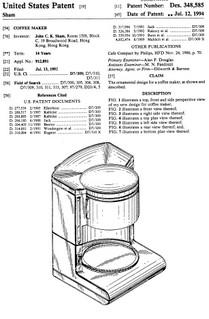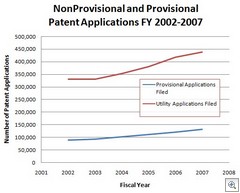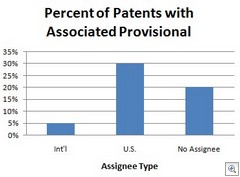By: Nicholas Witchey, Ph.D.; Robert D. Fish, Esq.; and the Fish & Associates team
Passage of the Leahy-Smith America Invents Act (AIA) includes many changes to U.S. patent law. This article focuses on one change that might be overlooked: Prioritized Examination ("PE") of patent applications. The PE program allows an applicant to pay an additional $4800 fee ($2800 for small entities) to place an application on a prioritized track where the patent office has a goal to provide final disposition of the application (i.e., final rejection or allowance) within a year on average. Interestingly, the AIA retains the Accelerated Examination ("AE") program established on August 26, 2006, as discussed in MPEP 708.02(a). While the PE program prioritizes an application for prosecution ahead of standard filings, the AE program prioritizes and accelerates the actual prosecution of the application. The prioritized examination and accelerated examination programs co-exist as of September 26, 2011.
We recently had a chance to discuss co-existence of the AE and PE programs with Robert W. Bahr, Acting Associate Commissioner for Patent Examination Policy, during a recent MarcusEvans? IP Law Summit in September, 2011. Mr. Bahr stated there are no current plans to make changes to the AE program to align it with the PE program, or vice versa. He sees both programs as viable examination routes for applicants, and that applicants are expected to make a business decision as to which program should be taken. Therefore, it is up to the applicant to work with their patent practitioners on how best to align patent filing tactics with clients' business objectives.
How do these programs compare and which makes the most sense to use? The AE program and PE program are far from identical and have many differences, which gives rise to possible benefits in aligning patent application filing tactics with a client's business strategy.
One of the major differences is that the PE process does not require a pre-examination search document ("PESD") and an accelerated examination support document ("AESD") whereas these documents are required for the AE program to illustrate how the claims of an AE application are allowable over known related art. Preparation of the PESD and AESD documentation requires significant searching and analysis on part of the practitioner. Following the PE program can save an applicant $10,000 or more over the AE program in searching and analysis costs, but that doesn't necessarily mean the total cost is less expensive over a lifetime of an application's prosecution. Within the AE program, the time spent in searching for related art and in improving/focusing the claims tends to yield stronger claim sets, which contributes to faster allowance possibly within months of being accepted into the AE program. Without such thoroughly analyzed claim sets, an applicant could spend $10,000 and many years going back and forth with the examiner to achieve allowance for an application filed within the PE program.
Other than PESD and AESD considerations, the basic requirements for putting an application on file are the same for AE and PE applications, (e.g., formal drawings, no missing part, correct margins, etc.) except that the AE process allows only 3 independent claims and 20 total claims, while the PE process allows 4 independent claims and 30 total claims subject to excess claim fees. In both cases failure to follow the filing rules will result in the petition being dismissed or denied.
There is also a significant difference in fees. The filing fees of an AE application for a large entity are $1380, which includes $130 in petition fees, $1250 in filing fees, plus any excess page size fees. Corresponding small entity filing fees are $660 plus any excess page size fees. In contrast, the filings fees of a PE application for a large entity are $6480, including $4800 in petition fees, $1250 in filing fees, a $130 processing fee, and a $300 publication fee, plus excess claim and page size fees. The corresponding total for a small entity is $3630, plus excess claims and page size fees. From purely a filing fee point of view, the AE program is less expensive. Micro entity discounts do not apply to a PE application petition fee.
Prosecution is also different. AE turnaround is one month on non-final office actions, and failure to meet that strict time requirement results in abandonment of the application. Within the PE program turnaround is the normal three months. The three month deadlines can be extended as usual, but doing so results in the application falling out of the PE program. Applications that have fallen out of the PE program are placed on an examiner's standard docket. Thus, the AE program returns faster results than the PE program, but also has more severe consequences when the response dates are missed.
There are also some inconsistencies in availability of AE and PE applications. For example, one can file a PE application for a plant, while the AE program can not be used for plant patent applications. At least initially, the PE program is also being limited to 10,000 applications per USPTO fiscal year. There doesn't seem to be a formal limit on the number of AE applications, but there have only been an average of about 800 AE applications filed per year so there is little concern with respect to the USPTO limiting AE submissions.
With the introduction of the AE program, the PE program, and other prosecution tracks, the USPTO appears to be developing a full spectrum of possible approaches for prioritizing patent applications rather than a one-size-fits-all approach. Clients can select a style of examination based on their business needs or available budgets. If a cost-effective immediate feedback is required, the PE program might be a proper path for clients wishing to get prosecution started early. If a strategic set of claims are required, the AE program would likely be the best approach for clients wishing to obtain issued claims quickly. We expect the PE program to likely fill their allocated 10,000 applications per fiscal year quickly. In fact, our office has already started filing application with PE petitions. When the allotted yearly slots are taken, the AE program will remain available.
Our office has substantial experience with the AE program, and, although we are strong advocates of the AE program, we believe that PE program also offers other benefits to clients. Clients now have a greater selection of filing options to meet their business goals or filing budgets. A detailed analysis that one would conduct for an AE application would still have merit when filing an application within the PE program. There may even be cases where an applicant might strategically decide to file an application, or a family of applications, in both programs to obtain an optimized result.
The AIA also allows for changes to other prioritized programs including petitions to make special or important technologies, and patent prosecution highways. These programs can also be leveraged to prioritized examination and offer benefits to clients as well. We encourage readers to explore all the programs currently offered or that will be offered over the next 18 months.
 Scanner Technologies Corp. v. ICOS Vision Systems (
Scanner Technologies Corp. v. ICOS Vision Systems ( Deferred Examination I: For the current state of PTO backlog, I am a strong believer in providing a mechanism to either (i) allowing the inventor pay to move to the front of the examination line if the patent needs to be obtained quickly or (ii) allowing the inventor to delay prosecution if it is unclear whether the invented technology will have any market value. There are some potential negative issues of allowing deferred prosecution — particularly the potential for submarining and shifting claim scope to encompass market changes. These problems would largely be limited through early publication of deferred applications as well as continued enforcement of the written description and enablement requirements. In addition, the patent term should continue to run during deferment.
Deferred Examination I: For the current state of PTO backlog, I am a strong believer in providing a mechanism to either (i) allowing the inventor pay to move to the front of the examination line if the patent needs to be obtained quickly or (ii) allowing the inventor to delay prosecution if it is unclear whether the invented technology will have any market value. There are some potential negative issues of allowing deferred prosecution — particularly the potential for submarining and shifting claim scope to encompass market changes. These problems would largely be limited through early publication of deferred applications as well as continued enforcement of the written description and enablement requirements. In addition, the patent term should continue to run during deferment. 
